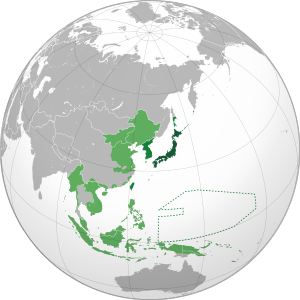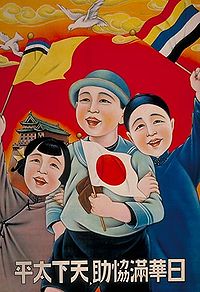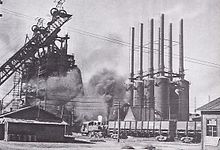History of Japanese foreign relations
By 1944, Japan was heavily on the defensive, as its Greater East Asia Co-prosperity Sphere collapsed, its navy was sunk, and American bombing started to devastate major Japanese cities.
Following the Russian invasion of Ukraine in 2022, Japan condemned it and implemented sanctions, including freezing assets and banning new investments and exports of high-tech goods.
The Iwakura Mission, the most important one, was led by Iwakura Tomomi, Kido Takayoshi and Ōkubo Toshimichi, contained forty-eight members in total and spent two years (1871–73) touring the United States and Europe, studying every aspect of modern nations, such as government institutions, courts, prison systems, schools, the import-export business, factories, shipyards, glass plants, mines, and other enterprises.
Exports of tea, silk and other Japanese products multiplied by a factor of four in four years, dramatically stimulating the local economy while causing galloping inflation that drove up the price of rice.
[3] Starting in the 1860s Japan rapidly modernized along Western lines, adding industry, bureaucracy, institutions and military capabilities that provided the base for imperial expansion into Korea, China, Taiwan and islands to the south.
The aftermath of these two wars left Japan the dominant power in the Far East with a sphere of influence extending over southern Manchuria and Korea, which was formally annexed as part of the Japanese Empire in 1910.
In the harsh Treaty of Shimonoseki of April 1895, China recognize the independence of Korea, and ceded to Japan Formosa, the Pescadores Islands, and the Liaotung Peninsula.
China further paid an indemnity of 200 million silver taels, opened five new ports to international trade, and allowed Japan (and other Western powers) to set up and operate factories in these cities.
He also gained control of the Liaodong Peninsula with Darien and Port Arthur, but was immediately forced by Russia, Germany and France acting together in the Triple Intervention to give that back to China.
[14] Itō sought to avoid a Russo-Japanese War through the policy of Man-Kan kōkan – surrendering Manchuria to the Russian sphere of influence in exchange for the acceptance of Japanese hegemony in Korea.
It was one thing to go to war with China or Russia, but quite another to be in conflict with key suppliers of raw materials such as the United States, Great Britain and the Netherlands, who supplied a majority of Japan's oil and iron.
The Americans, originally focused their efforts to help Czechoslovakian prisoners escape, increasingly, found their role was to watch and block Japanese expansion[citation needed].
[22] At the Paris Peace Conference in 1919, Japan was awarded a League of Nations mandate over a number of smaller islands and territory that had previously been part of the German Empire.
The Japanese operated in terms of traditional Power diplomacy, emphasizing control over distinct spheres of influence, while the United States adhered to Wilsonianism based on the "open door" and internationalist principles.
The new Prime Minister Inukai Tsuyoshi tried to negotiate with China, but was assassinated in the May 15 Incident in 1932, which ushered in an era of ultranationalism led by the Army and supported by patriotic societies.
Tokyo and Moscow signed a nonaggression treaty in April 1941, as the militarists turned their attention to the European colonies to the south which had urgently needed oil fields.
[36] The Army increasingly took control of the government, assassinated opposing leaders, suppressed the left, and promoted a highly aggressive foreign policy with respect to China.
[44] Hirohito's role in Japan's foreign wars remains a subject of controversy, with various historians portraying him as either a powerless figurehead or an enabler and supporter of Japanese militarism.
[45] The United States grew increasingly worried about the Philippines, an American colony, within close range of Japan and started looking for ways to contain Japanese expansion.
President Roosevelt imposed increasingly stringent economic sanctions intended to deprive Japan of the oil and steel it needed to continue its war in China.
After declaring war on the U.S., Britain and the Netherlands in December 1941, it quickly conquered British Malaya (Brunei, Malaysia, Singapore) as well as the Dutch East Indies (Indonesia).
It would purchase food, cotton, and iron ore at artificially low prices from the trailing Co-Prosperity Sphere geese, and sell them high-priced final products such as chemicals, fertilizers, and machinery.
The other allies and former colonial possessions of Japan demanded revenge, but MacArthur operated a highly favorable system in which harsh measures were limited to war criminals, who were tried and executed.
Yoshida shared and implemented MacArthur's goals was to democratize Japanese political, social and economic institutions, while completely de-militarizing the nation and renouncing its militaristic heritage.
[73] The occupation culminated in the Peace Treaty of 1951, signed by Japan, the United States, and 47 other involved nations, not including the Soviet Union or either Chinese government.
Historian Yone Sugita finds that "the 1950s was a decade during which Japan formulated a unique corporate capitalist system in which government, business, and labor implemented close and intricate cooperation".
It coordinated industry and government action and fostered cooperative arrangements, and sponsored research to develop promising exports as well as imports for which substitutes would be sought (especially dyestuffs, iron and steel, and soda ash).
[80] Nationalist politics have exacerbated this, such as denial of the Nanjing Massacre and other war crimes,[81] revisionist history textbooks, which provoked protests in East Asia.
[87] The war in Ukraine and threats from China and North Korea caused a shift in Japan's security policy with higher defense spending which erodes its former pacifist stance.
[87] On December 16, 2022, Japan announced a major shift in its military policy by acquiring counterstrike capabilities and a defense budget increase to 2% of GDP (¥43 trillion ($315 billion) by 2027.




